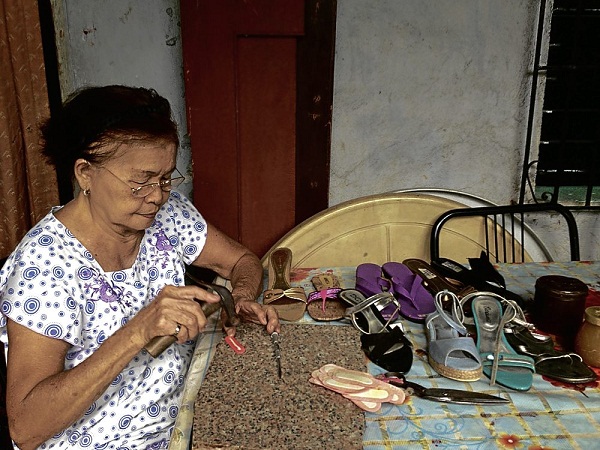The wrinkles on her hands reflect the lifelong mastery of her craft. When she starts hammering away to make yet another fine pair of Marikina footwear, her 80 years hardly show.
“I can still do this, of course,” Cleotilde de los Santos-Tiamzon said with a smile as she worked on the piece of brown leather in her shop in Calumpang, Marikina City.
Tiamzon, considered the oldest living footwear maker in the country’s shoe capital, is just one of the 120 craftsmen participating in the ongoing Sapatos Festival, the local government’s latest bid to prove that the homegrown industry is very much alive and kicking.
Like Tiamzon’s longevity, the festival—which kicked off on Sept. 10 as a trade caravan that goes from city to city around Metro Manila—may be considered a measure of endurance for the Marikina brand.
With about seven weeks to go before the travelling fair comes to a close on Dec. 31, the 41 local shoe manufacturers taking part in the festival are churning out impressive numbers.
As of Friday, sales have reached P30 million, accounting for some 60,000 pairs sold, according to the city’s public information office. Each pair is priced between P500 and P800.
The figure already covered 75 percent of the P40-million target set by the local government for this year’s festival. In 2011, the fair ran for only a month and earned P13 million.
“It was kind of overwhelming and much more than what we expected,” said Tiamzon, who currently works for a mid-size venture owned by Dennis Caballes. “It’s good that people still buy shoes from Marikina. I guess they still know that even if you have all those other foreign brands out, our products are different.”
HIGH HEELS ON WHEELS. When launched in September, the Sapatos Festival featured this giant mobile shoe, as though to show that the 10-year-old trade fair is far from slowing down despite the flood of imported footwear. JOAN BONDOC
Ryan Salvador, this year’s festival chair, said the 2012 fair also saw the highest number of participating manufacturers—about 40 percent of the 125 footwear makers currently in business—since the festival was launched 10 years ago. “They have seen the event’s profitability,” he said, gratefully noting the city government’s role in promoting the fair.
Salvador conceded that today’s Marikina shoe industry had shrunk significantly since its heydays in the 1950s, when up to 1,000 shops thrived and practically supplied footwear for the entire country.
With the wave of globalization sweeping across local industries, “cheap shoes from other countries just keep coming in,” he said. China alone exports shoes to the Philippines by the millions every year.
But despite this mounting challenge, Salvador remained optimistic of the local zapatero’s survival. “Good quality and durability” backed by “120 years of tradition” continue to be Marikina’s main selling pitch for its shoes, he said.
Aside from being more affordable, Marikina shoes owe their charm to experienced shoemakers like Tiamzon, who has spent more than 60 years of her life in the trade.
Most of today’s Marikina shoemakers learned the craft from their parents or grandparents who started making shoes before World War II, she said. This gives them an edge over other craftsmen who don’t have this long tradition.
In those olden times, for example, local shoemakers had to learn by hand how to make the leather softer. “Nowadays you have machines for that. But it’s different if you know how to do this manually since you get to feel the material better.”
She learned this skill, called dasdas, at such an early age that by the time she was in her 20s she was already producing footwear custom-made for the likes of Susan Roces, a show biz princess of the period. She made at least five pairs for the actress.
“I very well remember her size. Size 7!” she exclaimed, adding that the movie star preferred shiny leather as material.
Of late, Tiamzon has branched out to making belts, bags and other leather goods— “piece of cake” for Marikina shoemakers.
Still, she said, “the most challenging for me are men’s shoes since they are bigger and the material used is usually thicker. But if you know how to do that, bags, belts and other leather goods are easy.”
At 80, Tiamzon doesn’t see herself stowing away her little hammer in the near future. “I make money doing this, so why should I stop? I’m not sick; no diabetes, no nothing. It must be shoemaking that’s making me live longer.”
Salvador noted that the “upward trend” in sales in the yearly Sapatos Festival indicates that consumers, despite the many choices available, “still know what Marikina can offer and what our competitors cannot.”
The Sapatos Festival is now back in its home city, in Barangay Sta. Elena.
